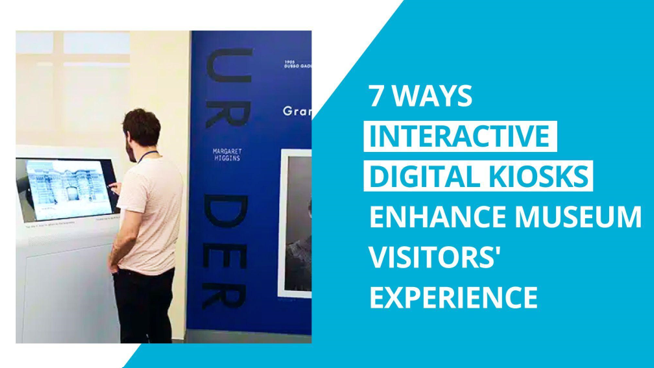Technology
7 Ways Interactive Digital Kiosks Enhance Museum Visitors’ Experience

Museums are a great way to learn about history, art, and culture. But sometimes, they can be a bit overwhelming. There is so much to learn and do, and it can be hard to know where to start. That is where interactive digital kiosks come in.
Interactive touch screen solutions are becoming increasingly popular in museums and for good reason. They offer a variety of benefits that can enhance the museum experience for visitors of all ages.
Interactive digital kiosks vs digital signage
Unlike wall-mounted digital signage, which is carefully customised to its surroundings, kiosks offer a more immersive experience for the user.
Digital signage offers few interactive features. On the contrary, an interactive kiosk’s touch screen technology enables physical transactions. It can also handle open-ended inquiries.
How can interactive kiosks improve the visitor experience in museums?
Engage your visitors in a better way
Interactive displays are a great way to engage visitors and help them learn more about the museum’s exhibits. There are many different ways to create interactive exhibits, but some of the most popular methods include:
- Touchscreen technology: allows visitors to interact with exhibits by touching the screen—this can be used to display information or even control exhibits
- Virtual reality experiences: (VR) experiences allow visitors to immerse themselves in the museum’s exhibits—this can be a great way to explore different cultures, learn about historical events, or even experience things that are impossible in the real world
Inform your visitors about artefacts in a unique way
Detailed information and multimedia content can help visitors learn more about the museum’s exhibits and artefacts:
- In-depth descriptions of exhibits and artefacts: these descriptions should be written clearly and concisely and easy to understand; they should include information about the object’s history, its significance, and how it was created
- Audio-visual materials: (such as videos, audio recordings, and interactive exhibits) can help visitors understand the museum’s exhibits in detail-they can provide additional information, create a more immersive experience, or even tell a story
Let visitors learn about exhibits in a fun way
Interactive quizzes and games are a fun and engaging way to allow visitors to learn more about the museum’s exhibits.
- Gamification elements for educational purposes: gamification uses game-like elements in non-game contexts, for example, a museum might use a quiz to help visitors learn about the different types of dinosaurs—the quiz may be designed to be challenging but not too tricky, and it could offer small rewards for correct answers
- Fun and interactive learning activities for all ages: interactive quizzes and games can make learning more accessible to a broader range of visitors, for example, a museum might create a scavenger hunt that leads visitors to different exhibits—it can include clues that require visitors to use their knowledge of the exhibits to solve
Allow visitors to navigate your museum easily
Interactive maps and wayfinding can help visitors find their way around the museum and make the most of their visit. Some of the most popular features of interactive maps and wayfinding include:
- Ease of navigation: interactive maps and wayfinding are easy to use and understand—visitors can quickly find the information they require, such as the location of exhibits, restrooms, and cafeterias
- Customised tours and personalised recommendations: interactive maps and wayfinding can help visitors make the most of their time at the museum and learn about the exhibits most relevant to their interests
Attract visitors from various demographics
If you are a museum director or curator, consider the benefits of providing multilingual options and accessibility accommodations. Touch screen solutions can be a valuable tool for enhancing the museum experience for visitors of all ages and abilities.
- Multilingual options for international visitors: museums can translate text and audio content into multiple languages or headphones with translation capabilities—offering multilingual options can make the museum experience more accessible to international visitors and can promote understanding and appreciation of different cultures
- Better accessibility for people with a disability: museums can also offer audio descriptions of exhibits for people who are blind or visually impaired and provide sign language interpreters for individuals with impaired hearing—providing accessibility options can make the museum experience more inclusive and ensure that all visitors can enjoy the museum’s exhibits and programs
Offer personalised recommendations
Personalised recommendations and notifications are tools that use visitor data to provide visitors with information that is relevant to their interests and needs. This can improve the user experience by making it more engaging and informative:
- Suggesting related exhibits or events based on visitor history: this can be done by offering related exhibitions or events based on visitor history, for example, a museum can suggest a dinosaur exhibit to visitors who have previously visited the museum’s palaeontology section
- Informing visitors about upcoming activities or special offers: museums can also use visitor data to inform visitors about upcoming activities or special offers, for example, a museum could send an email notification to visitors who have previously visited the museum’s art exhibit about a forthcoming art lecture
Museums benefit from interactive kiosks
Touch screen solutions are beneficial not only for visitors but also for museums. They can offer multiple advantages to museums:
- Self-service ticketing and information retrieval: museums can reduce staff workload and increase efficiency by offering self-service ticketing and information retrieval—they can allow visitors to purchase tickets online or at self-service kiosks and also provide access to information about the museum’s exhibits and programs through a mobile app or website
- Automated processes for smoother operations: museums can also reduce staff workload and increase efficiency by using automated systems for tasks such as reservations and gift shop purchases
Museums are embracing the technology
In recent years, interactive digital kiosks have grown in popularity. Because of their simplicity of use, they can be found in various businesses and greatly benefit people. Hence, it is no surprise that museums have also embraced these touchscreen solutions.





















